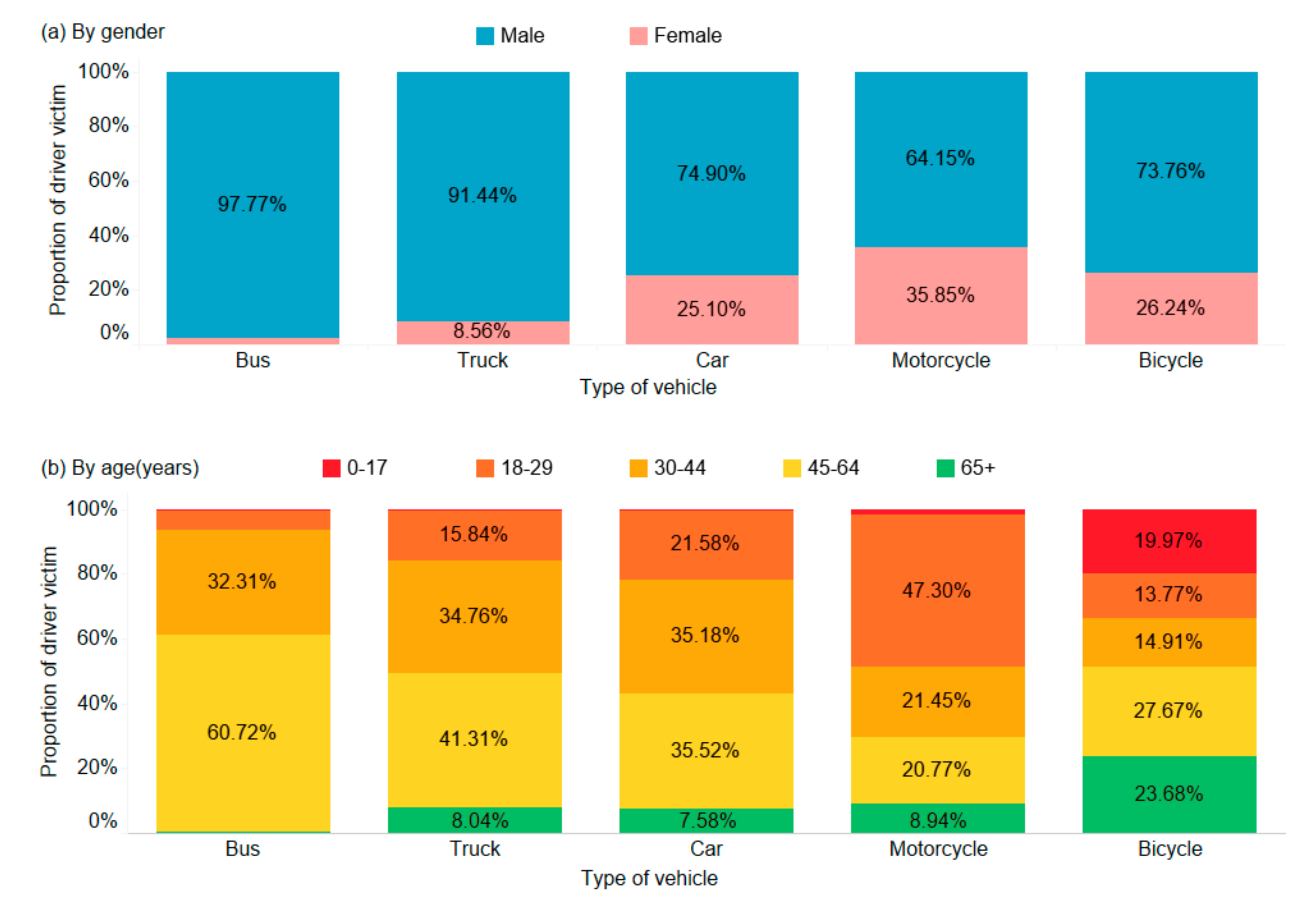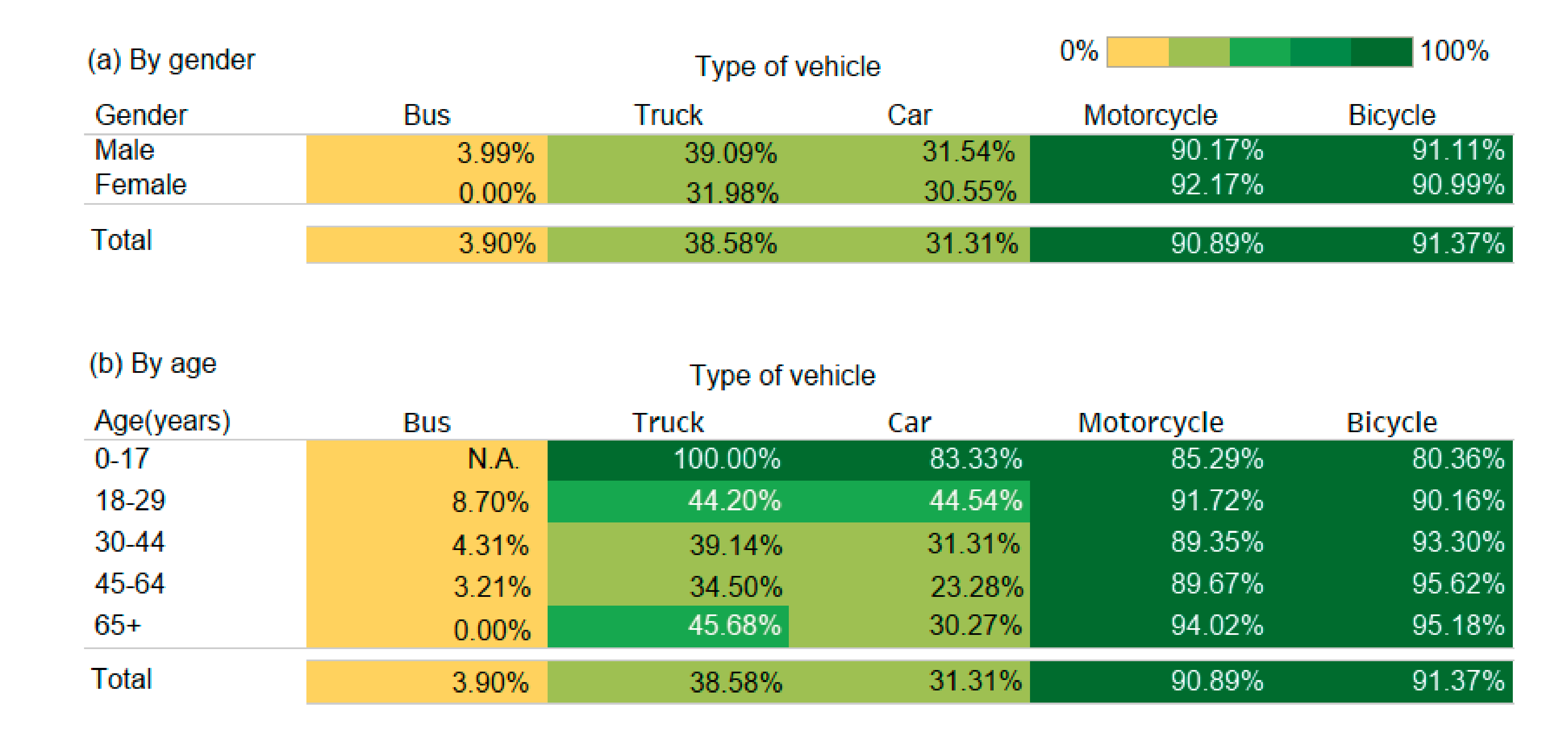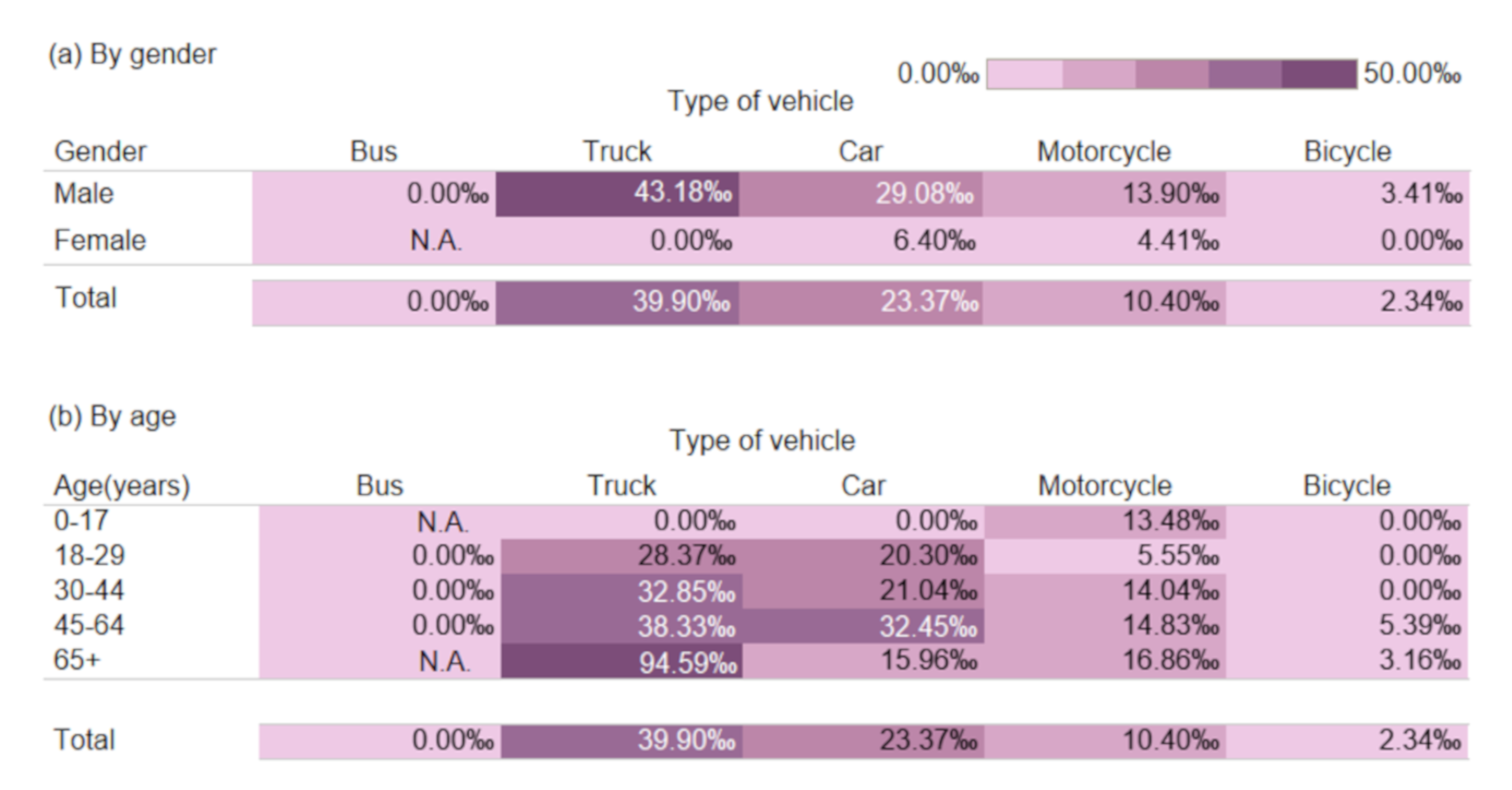Risk of Injury and Mortality among Driver Victims Involved in Single-Vehicle Crashes in Taiwan: Comparisons between Vehicle Types
Abstract
:1. Introduction
2. Materials and Methods
2.1. Source of Data and Study Design
2.2. Statistical Analysis
3. Results
4. Discussion
4.1. Main Findings
4.2. Sex and Age Variability of Injury and Fatality by Vehicle Type
4.3. Study Strengths and Limitations
5. Conclusions
Author Contributions
Funding
Acknowledgments
Conflicts of Interest
References
- WHO. Global Status Report on Road Safety 2018; World Heal Organ: Geneva, Switzerland, 2018. [Google Scholar]
- Ministry of Transportation and Communication, R.O.C. Traffic Accidents. 2019. Available online: https://stat.motc.gov.tw/mocdb/stmain.jsp?sys=100 (accessed on 19 June 2020).
- International Transport Forum. Road Safety Annual Report 2018; International Traffic Safety Data and Analysis Group (IRTAD)/OECD: Paris, France, 2018; ISBN 9789282132630. [Google Scholar]
- Yau, K.K. Risk factors affecting the severity of single vehicle traffic accidents in Hong Kong. Accid Anal. Prev. 2004, 36, 333–340. [Google Scholar] [CrossRef]
- Wang, C.H.; Hsieh, W.H.; Liang, F.W.; Lu, T.H. Using matrix frame to present road traffic injury pattern. Inj. Epidemiol. 2018, 5, 22. [Google Scholar] [CrossRef] [PubMed]
- Xiong, L.; Li, L. Single-vehicle and multi-vehicle accidents involving motorcycles in a small city in China. Characteristics and injury patterns. AIMS Public Health 2015, 2, 74–85. [Google Scholar] [CrossRef] [PubMed]
- Martensen, H.; Dupont, E. Comparing Single Vehicle and Multivehicle Fatal Road Crashes: A Joint Analysis of Road Conditions, Time Variables and Driver Characteristics. Accid Anal. Prev. 2013, 60, 466–471. [Google Scholar] [CrossRef] [PubMed]
- Behnood, A.; Mannering, F.L. The temporal stability of factors affecting driver-injury severities in single-vehicle crashes: Some empirical evidence. Anal. Methods Accid Res. 2015, 8, 7–32. [Google Scholar] [CrossRef]
- Wåhlberg, A. Driver Behaviour and Accident Research Methodology: Unresolved Problems; Ashgate: Farnham, UK, 2009. [Google Scholar]
- Li, Z.; Ci, Y.; Chen, C.; Zhang, G.; Wu, Q.; Qian, Z.S.; Prevedouros, P.D.; Ma, D.T. Investigation of Driver Injury Severities in Rural Single-Vehicle Crashes Under Rain Conditions Using Mixed Logit and Latent Class Models. Accid Anal. Prev. 2019, 124, 219–229. [Google Scholar] [CrossRef] [PubMed]
- Ministry of the Interior. Regulations Governing Road Traffic Accidents. 2015. Available online: https://law.moj.gov.tw/ENG/LawClass/LawAll.aspx?pcode=D0080090 (accessed on 19 June 2020).
- Behnood, A.; Mannering, F.L. The effects of drug and alcohol consumption on driver injury severities in single-vehicle crashes. Traffic Inj. Prev. 2017, 18, 456–462. [Google Scholar] [CrossRef] [PubMed]
- Kim, K.; Brunner, I.M.; Yamashita, E. Modeling fault among accident—Involved pedestrians and motorists in Hawaii. Accid Anal. Prev. 2008, 40, 2043–2049. [Google Scholar] [CrossRef] [PubMed]
- Zhou, H.; Zhao, J.; Pour-Rouholamin, M.; Tobias, P.A. Statistical characteristics of wrong-way driving crashes on Illinois freeways. Traffic Inj. Prev. 2015, 16, 760–767. [Google Scholar] [CrossRef] [PubMed]
- Kelley-Baker, T.; Romano, E. Female involvement in U.S. nonfatal crashes under a three-level hierarchical crash model. Accid Anal. Prev. 2010, 42, 2007–2012. [Google Scholar] [CrossRef] [PubMed] [Green Version]
- Pai, C.W.; Lin, H.Y.; Tsai, S.H.; Chen, P.L. Comparison of traffic-injury related hospitalisation between bicyclists and motorcyclists in Taiwan. PLoS ONE 2018, 13, e0191221. [Google Scholar] [CrossRef] [PubMed] [Green Version]
- Feleke, R.; Scholes, S.; Wardlaw, M.; Mindell, J.S. Comparative fatality risk for different travel modes by age, sex, and deprivation. J. Transp. Health 2018, 8, 307–320. [Google Scholar] [CrossRef]
- Öström, M.; Eriksson, A. Single-vehicle crashes and alcohol: A retrospective study of passenger car fatalities in Northern Sweden. Accid Anal. Prev. 1993, 25, 171–176. [Google Scholar] [CrossRef]
- Cordellieri, P.; Baralla, F.; Ferlazzo, F.; Sgalla, R.; Piccardim, L.; Giannini, A.M. Gender effects in young road users on road safety attitudes, behaviors and risk perception. Front. Psychol. 2016, 7, 1412. [Google Scholar] [CrossRef] [PubMed] [Green Version]
- Regev, S.; Rolison, J.J.; Moutari, S. Crash risk by driver age, gender, and time of day using a new exposure methodology. J. Saf. Res. 2018, 66, 131–140. [Google Scholar] [CrossRef] [PubMed]
- Al-Reesi, H.; Al-Maniri, A.; Adawi, S.A.; Davey, J.; Armstrong, K.; Edwards, J. Prevalence and characteristics of road traffic injuries among young drivers in Oman, 2009–2011. Traffic Inj. Prev. 2016, 17, 480–487. [Google Scholar] [CrossRef] [PubMed] [Green Version]
- Bener, A.; Ghaffar, A.; Azab, A.; Sankaran-Kutty, M.; Toth, F.; Lovasz, G. The impact of four-wheel drives on road traffic disability and deaths compared to passengers cars. J. Coll. Physicians Surg. Pak. 2006, 16, 257–260. [Google Scholar] [PubMed]
- Department of Health. Taiwan Public Health Report; Department of Health: Taipei, Taiwan, 2010.
- Council for Economic Planning and Development. 2008–2056 Population Estimation in Taiwan; Council for Economic Planning and Development: Taipei, Taiwan, 2008.



| Vehicle Type | |||||||||||||||
|---|---|---|---|---|---|---|---|---|---|---|---|---|---|---|---|
| Bus | Truck | Car | Motorcycle | Bicycle | |||||||||||
| No. of Victim | No. of Injured | No. of Dead | No. of Victims | No. of Injured | No. of Dead | No. of Victims | No. of Injured | No. of Dead | No. of Victims | No. of Injured | No. of Dead | No. of Victims | No. of Injured | No. of Dead | |
| Gender | |||||||||||||||
| Male | 351 | 14 | 0 | 1837 | 718 | 31 | 6106 | 1926 | 56 | 18,032 | 16,260 | 226 | 967 | 881 | 3 |
| Female | 8 | 0 | 0 | 172 | 55 | 0 | 2046 | 625 | 4 | 10,079 | 9290 | 41 | 344 | 313 | 0 |
| Age (yrs) | |||||||||||||||
| 0–17 | 0 | 0 | 0 | 1 | 1 | 0 | 12 | 10 | 0 | 435 | 371 | 5 | 280 | 225 | 0 |
| 18–29 | 23 | 2 | 0 | 319 | 141 | 4 | 1769 | 788 | 16 | 13,356 | 12,250 | 68 | 193 | 174 | 0 |
| 30–44 | 116 | 5 | 0 | 700 | 274 | 9 | 2884 | 903 | 19 | 6057 | 5412 | 76 | 209 | 195 | 0 |
| 45–64 | 218 | 7 | 0 | 832 | 287 | 11 | 2912 | 678 | 22 | 5866 | 5260 | 78 | 388 | 371 | 2 |
| 65+ | 2 | 0 | 0 | 162 | 74 | 7 | 621 | 188 | 3 | 2523 | 2372 | 40 | 332 | 316 | 1 |
| Total a | 359 | 14 | 0 | 2014 | 777 | 31 | 8198 | 2567 | 60 | 28,237 | 25,665 | 267 | 1402 | 1281 | 3 |
© 2020 by the authors. Licensee MDPI, Basel, Switzerland. This article is an open access article distributed under the terms and conditions of the Creative Commons Attribution (CC BY) license (http://creativecommons.org/licenses/by/4.0/).
Share and Cite
Chang, Y.-H.; Li, C.-Y.; Lu, T.-H.; Artanti, K.D.; Hou, W.-H. Risk of Injury and Mortality among Driver Victims Involved in Single-Vehicle Crashes in Taiwan: Comparisons between Vehicle Types. Int. J. Environ. Res. Public Health 2020, 17, 4687. https://doi.org/10.3390/ijerph17134687
Chang Y-H, Li C-Y, Lu T-H, Artanti KD, Hou W-H. Risk of Injury and Mortality among Driver Victims Involved in Single-Vehicle Crashes in Taiwan: Comparisons between Vehicle Types. International Journal of Environmental Research and Public Health. 2020; 17(13):4687. https://doi.org/10.3390/ijerph17134687
Chicago/Turabian StyleChang, Ya-Hui, Chung-Yi Li, Tsung-Hsueh Lu, Kurnia Dwi Artanti, and Wen-Hsuan Hou. 2020. "Risk of Injury and Mortality among Driver Victims Involved in Single-Vehicle Crashes in Taiwan: Comparisons between Vehicle Types" International Journal of Environmental Research and Public Health 17, no. 13: 4687. https://doi.org/10.3390/ijerph17134687
APA StyleChang, Y.-H., Li, C.-Y., Lu, T.-H., Artanti, K. D., & Hou, W.-H. (2020). Risk of Injury and Mortality among Driver Victims Involved in Single-Vehicle Crashes in Taiwan: Comparisons between Vehicle Types. International Journal of Environmental Research and Public Health, 17(13), 4687. https://doi.org/10.3390/ijerph17134687






